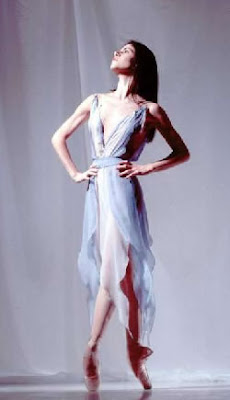Paloma Herrera - notice how she looks very lifted and long, but her ribs are not splayed, or sticking out. The length is coming from her spine and back.
Last week we focused on the arms and explained how they are connected to the back and shoulders. But did you know the placement of your rib cage also affects your arms? Not only that, it affects your head, neck and even lower back, so paying close attention to your ribs and keeping them from sticking out is very important to your overall body placement. Check out this article from Dance Magazine to get tips to improve your rib placement!
Break Your Bad Habits: The Rib Cage by Lauren Kay
The placement of the rib cage affects the placement of everything around it: the head and neck, the arms, the lower back. Splaying open the ribs or letting them slouch—even if it feels comfortable—can throw off your line and make your movement more effortful than it needs to be. To help you kick those habits, Dance Magazine spoke with dance medicine practitioner Deborah Vogel; master Horton teacher Milton Myers; and Lupe Serrano, ballet teacher at the JKO School at American Ballet Theatre.
Habit: Splaying the ribs Dancers often pop the rib cage out and up to achieve extra height and presence. But this hyperextended position “appears stiff, tight, tense, haughty, and unattainable, though that’s often not the characterization the dancer wants,” Vogel says. Serrano agrees: “The problem starts with wanting to appear elegant and regal. But style should not interfere with the neutral position.” Myers adds that the lift can result from “trying to feel like you are up on top of the legs, but this distorts the rib cage—and the entire line of the body.”
Break it: Vogel says this problem is often more mental than physical. Many students have a limited awareness of the rib cage’s full three-dimensional range and its relationship to the breath. “The rib cage is like an umbrella,” she says. “When you inhale, the sides expand and the pole of the umbrella, or the spine, stays tall and straight. When you close the umbrella, or exhale, the pole stays in its erect position and the umbrella simply folds around it.”
She suggests a simple exercise for developing awareness of the ribs. “Wrap a Thera-Band around your rib cage,” she says. “Breathe in and notice how the Thera-Band—and your ribs—move laterally in all directions. Also notice that the height of your rib cage doesn’t change. Do this three times with an equal length of your inhale and exhale. Then try it with the exhale twice as long to make sure you aren’t holding your breath.”
Serrano asks her students to focus on the shoulders and back. “I tell a dancer with an overextended rib cage not to carry the shoulders behind the hips. Align them with the hips, and rely on the back more than your chest for pull-up.” Also think of knitting together the space between the pubic bone and sternum and maintaining a strong connection between navel and spine.
Habit: Slouching In contrast to thrusting the rib cage forward, some dancers drop the rib cage back and down. This can result from overtucking the pelvis, which causes the upper body to sink backwards. Myers thinks this tendency stems from neglecting alignment during breaks. “My teacher, Joyce Trisler, explained that dancers tend to ‘prepare’ and put the body in proper alignment,” he says. “But in between exercises, we slump. Unfortunately, the body remembers the slump because you’re doing that for more time than the exercise.”
Break it: “Joyce told us to imagine someone holding your leotard or shirt in the back and pulling it taut,” says Myers. “Your front expands to the sides and this helps to develop the back muscles. Then, that becomes what your body remembers.” Whether warming up or resting on the sidelines, this image can help you energize the upper body and bring the rib cage into a more upright alignment.
Vogel suggests focusing on the separation of rib cage and spine. “Length is actually achieved with the spine, not the ribs,” she explains. “Articulate and elongate the spine, and the ribs should simply hang around it.” Finding this length, she adds, “requires building strength between the shoulder blades. Try twisted push-ups against the wall.” Stand with both hands against a wall, arms straight, so that your torso is facing the wall but your hips are twisted to the side. Bend your arms, keeping the elbows close to your body, and push back up. Do 10–20 reps on each side, once a day. “If you can get the back stronger,” Vogel says, “the shoulders will come back and the rib cage will move into its proper position so you can stand tall and straight.”
Lauren Kay is a contributing editor at Dance Spirit magazine.



No comments:
Post a Comment